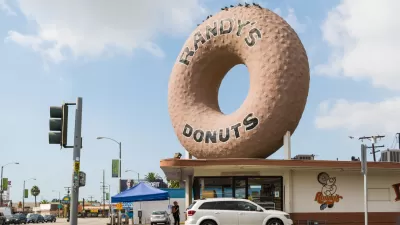Passion for urban planning, love of South Central LA communities, and historical background of the neighborhoods combine in this personal account by Jonathan P. Bell of community-based zoning enforcement.

The area considered to be South Central Los Angeles is geographically inexact but generally encompasses neighborhoods like Compton, Watts, East Rancho Dominguez ("ERD"), Crenshaw, Florence-Firestone, Vermont Central, Willowbrook, and others. Some neighborhoods lie within the boundaries of the city of Los Angeles, other parts are unincorporated and are served by County departments. The area's reputation is perhaps overly-defined by the rap music lyrics of the '90s that described the harder aspects of life there. Now a new challenge is encroaching on the area: gentrification displacement.
In this context, zoning enforcement does not seem a particularly resonant or compelling topic. However, much has been recently made of the benefits community-based policing. Jonathan P. Bell, a County planner working mostly in the field, argues that a community-based approach is also beneficial in zoning enforcement. Perhaps counter-intuitively, Bell is convinced that this style of zoning code enforcement—prioritizing education and helpfulness over threat and punitive measures—actually helps fight displacement from gentrification by giving community members the knowledge and contacts to use the municipal code and land use policies to support community goals. In this account, Bell describes some of the history of the area, his own background and affinity for these neighborhoods, and his passion for and style of in-the-field urban planning. For example, responding to a question from a community member about his job, Bell contrasts his job to an office-based planner:
In contrast, I tell him, enforcement planners work directly with community members to solve neighborhood problems. Our job is to enforce the zoning code to remove violations – like those neighbors with trash all over the yard, we can get that cleaned up.
I tell him about the variety of informal housing arrangements I’ve seen over the years – garages converted into apartments, garden sheds modified into micro units, houses discreetly cut up into mini-hotels, an occupied U-Haul trailer on someone’s driveway – and how demand for these dwellings has risen in this housing crisis.
I point east and explain how we serve the people of ERD, and I explain this unincorporated territory next door.
“We respond to reports of all kinds of unpermitted housing, but we work with property owners to get permits. It’s planning on the ground,” I say. “We educate people while we enforce.”
For Bell's full account, please read the source article.
FULL STORY: An Urban Planner on the Ground in South Central Los Angeles

Planetizen Federal Action Tracker
A weekly monitor of how Trump’s orders and actions are impacting planners and planning in America.

Restaurant Patios Were a Pandemic Win — Why Were They so Hard to Keep?
Social distancing requirements and changes in travel patterns prompted cities to pilot new uses for street and sidewalk space. Then it got complicated.

Map: Where Senate Republicans Want to Sell Your Public Lands
For public land advocates, the Senate Republicans’ proposal to sell millions of acres of public land in the West is “the biggest fight of their careers.”

Maui's Vacation Rental Debate Turns Ugly
Verbal attacks, misinformation campaigns and fistfights plague a high-stakes debate to convert thousands of vacation rentals into long-term housing.

San Francisco Suspends Traffic Calming Amidst Record Deaths
Citing “a challenging fiscal landscape,” the city will cease the program on the heels of 42 traffic deaths, including 24 pedestrians.

California Homeless Arrests, Citations Spike After Ruling
An investigation reveals that anti-homeless actions increased up to 500% after Grants Pass v. Johnson — even in cities claiming no policy change.
Urban Design for Planners 1: Software Tools
This six-course series explores essential urban design concepts using open source software and equips planners with the tools they need to participate fully in the urban design process.
Planning for Universal Design
Learn the tools for implementing Universal Design in planning regulations.
Heyer Gruel & Associates PA
JM Goldson LLC
Custer County Colorado
City of Camden Redevelopment Agency
City of Astoria
Transportation Research & Education Center (TREC) at Portland State University
Camden Redevelopment Agency
City of Claremont
Municipality of Princeton (NJ)




























